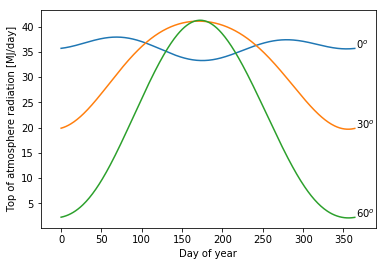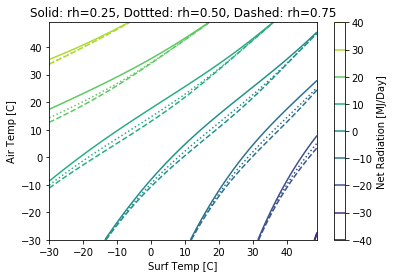Net Radiation Calculation Example
The incoming radiation $K_{In}$ is important for a lot of processes in physical hydrology. See appendix D.2 for this
Extraterrestrial Solar Radiation
For a given latitidue ($lat$) and day of year ($J$), we can estimate the radiation outside the earth. First we calcuate the day angle ($\Gamma$)
$$ \Gamma = \frac{2 \pi (J-1)}{365} $$Next we calculate the orbital eccentricity (r0/r) which is the square of the ratio of the average distance, r0, to the distance at any time, r. This is calculated as
$$ E0 = 1.000110 + 0.034221\cos(\Gamma) + 0.001280\sin(\Gamma) $$$$ + 0.000719\cos(2\Gamma) + 0.000077*\sin(2\Gamma) $$Next we need the solar declination ($\delta$), which is the angle between the plane of the equator and the rays of the sun; it is equal to the latitude at which the sun is directly overhead at noon.
$$ \delta = 0.006918 – 0.399912\cos(\Gamma) + 0.070257\sin(\Gamma) – 0.006758\cos(2 \Gamma)$$$$ + 0.000907 sin(2\Gamma) – 0.002697\cos(3\Gamma) + 0.00148\sin(3\Gamma)$$And the hour that it will rise and set
$$ T_R = -\frac{ \cos^{-1}\left[-\tan(\delta)\tan(lat)\right]}{\omega} $$$$ T_S = +\frac{ \cos^{-1}\left[-\tan(\delta)\tan(lat)\right]}{\omega} $$These are then integrated over the day to get the total radiation at the top of atmosphere.
# Import numeric python and the plotting library
import numpy as np
import matplotlib.pyplot as plt
%matplotlib inline
# Solar Constant
S = 4.910 # MJ/hr/m2
omega = 0.2618 # Angular velocity of earth [rad/hr]
# Example Point and Time
lat = 44.5704
doy = 274 # Oct 1
time = 12
# Day Angle Calculation
def getAngle(doy):
dayAngle = 2 * np.pi * (doy-1)/365
return dayAngle
print('dAngle',getAngle(doy))
# Declination
def getDec(doy):
dAngle = getAngle(doy)
declination = (0.006918 -
0.399912*np.cos(dAngle) +
0.070257*np.sin(dAngle) -
0.006758*np.cos(2*dAngle) +
0.000907*np.sin(2*dAngle) -
0.002697*np.cos(3*dAngle) +
0.00148* np.sin(3*dAngle))
return declination
print('declination',getDec(doy))
# Orbital Eccentricity
def getEcc(doy):
dAngle = getAngle(doy)
ecc = (1.000110+
0.034221*np.cos(dAngle)+
0.001280*np.sin(dAngle)+
0.000719*np.cos(2*dAngle)+
0.000077*np.sin(2*dAngle))
return ecc
print('E0:', getEcc(doy))
# Rise and Set time
def getTRTS(doy, lat):
declination = getDec(doy)
TR = -np.arccos(-np.tan(declination)*np.tan(lat))/omega
TS = +np.arccos(-np.tan(declination)*np.tan(lat))/omega
return TR, TS
print('TR, TS:',getTRTS(doy,lat))
# Daily Total Extraterrestrial Solar Radiation [MJ/day]
def getKE(doy,lat):
declination = getDec(doy)
ecc = getEcc(doy)
TR, TS = getTRTS(doy,lat)
KE = 2*S*ecc*(
np.sin(lat)*np.sin(declination)*TS +
np.cos(lat)*np.cos(declination)*np.sin(omega*TS)/omega)
return KE
print('KE',getKE(doy,lat))
days = np.arange(365)
lats = [0,30,60]
# Empty matrix to hold output
matKE = np.zeros((len(days),len(lats)))*np.nan
# For loops:
plt.figure(1)
for l in np.arange(len(lats)):
for d in np.arange(len(days)):
curDay = days[d]
curLat = lats[l]*np.pi/180
matKE[d,l] = getKE(curDay,curLat)
plt.plot(days,matKE[:,l])
plt.text(366,matKE[d,l],'%d$^o$'%lats[l])
plt.xlim(-25,365+25)
plt.xlabel('Day of year')
plt.ylabel('Top of atmosphere radiation [MJ/day]')
plt.show()
Net Radiation
Given that we have the radiation above the atmosphere, we must account for the transmissivitiy of the atmosphere ($\tau_{atm}$), of clouds ($\tau_{C}$) and of forest/plant cover ($\tau_{F}$). This can be expressed as
$$ K_{in} = \tau_{atm}\tau_{C}\tau_{F}K_{ET} $$($\tau_{atm}$), it's cloud cover ($\tau_{cc}$), and any vegetation ($\tau_{veg}$). All these things can decrease radiation and can be estimated from Appendix D or Chapter 5.
For the context of this example we'll assume $\tau_{total}=0.75$, i.e. $K_{in}$ = 0.75 $K_{ET}$; but see Appendix D for more detailed calculation methods. Finally, the net shortwave radiation is determined by the albedo of the surface as:
$$ K_{net} = K_{In}-K_{out} = (1-a) K_{in} $$For the longwave radiation, we have a similar balance as
$$ L_{net} = L_{In}-L_{out} $$where the incoming and outgoing longwave energy is a function of the temperature (following Stephan-Boltzman).
$$ L_{in} = \epsilon_{atm} \sigma T_{atm}^4 $$$$ L_{in} = \epsilon_{surf} \sigma T_{surf}^4 $$with $\epsilon$ the emisivity of the media. Here we adjust the emisivity of the atmosphere based on the vapor pressure as:
$$ \epsilon = 0.83 - 0.18 \exp(-1.54 e_a) $$where $e_a$ is the atmospheric vapor pressure
# Surfce Condtions and Constants
albedo = 0.5 # For snow
tAir = 40
rh = 0.6
tSurf = 0
tau = 0.75
# Calcuate net shortwave
def getKnet(doy,lat,albedo,tau):
KE = getKE(doy,lat)
Knet = (1-albedo) * tau *KE
return Knet
print('Knet',getKnet(doy,lat,albedo,tau))
# Incoming Longwave
def getLnet(tAir,tSurf,rh):
sb_constant = 4.90 * 10**-9 # [MJ/m2 k4 day]
e_atm = 0.611*np.exp(17.3*tAir/(tAir+237.3))*rh
eps_atm = 0.83 - 0.18*np.exp(-1.54*e_atm)
# Incoming longwave
Lin = eps_atm * sb_constant * (tAir+273.15)**4
# Outgoing Longwave
eps_snow = 1
Lout = eps_snow * sb_constant * (tSurf+273.15)**4
# Net Longwave
Lnet = Lin - Lout
return Lnet
print('Lnet',getLnet(tAir,tSurf,rh))
# Total Net Radiation
def getRnet(doy,lat,albedo,tau, tAir,tSurf,rh):
Rnet = getKnet(doy,lat,albedo,tau) + getLnet(tAir,tSurf,rh)
return Rnet
print('Net Radiation:',getRnet(doy,lat,albedo,tau, tAir,tSurf,rh))
v1 = np.arange(-30,50,1); # Tair
v2 = np.arange(-30,50,1); # Tsurf
v3 = np.array([0.25, 0.5, 0.75]); # Relative Humidity
outMat = np.zeros((len(v1),len(v2),len(v3)))
# Evaluate Different Condtions
for i in np.arange(len(v1)):
for j in np.arange(len(v2)):
for k in np.arange(len(v3)):
cV1 = v1[i]
cV2 = v2[j]
cV3 = v3[k]
outMat[i,j,k] = getRnet(doy,lat,albedo,tau,cV1,cV2,cV3)
# Make A Plot
plt.figure(2)
plt.contour(v1,v2,outMat[:,:,0],label='Tau')
plt.contour(v1,v2,outMat[:,:,1],linestyles=':')
plt.contour(v1,v2,outMat[:,:,2],linestyles='--')
plt.xlabel('Surf Temp [C]'); plt.ylabel('Air Temp [C]')
plt.title('Solid: rh=%.2f, Dottted: rh=%.2f, Dashed: rh=%.2f'% (v3[0],v3[1],v3[2]))
plt.colorbar(label='Net Radiation [MJ/Day]');
plt.show()


